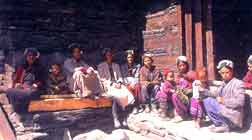Most of the people in Himachal depend on agriculture for livelihood. Many people derive their income from sheep, goats, and other cattle. Ninety percent of the people live in villages and small towns. Villages usually have terraced fields and small two storey houses with sloping roof. The villages are mostly self-contained with a few shops to take care of basic necessities of life. Most villages have a temple, where people congregate for worship. In many parts of the Himachal the village Gods are carried on palanquins to village fairs. On Dussehra the largest congregation of village Gods takes place at Kullu. The folk songs of Himachal Pradesh are full of charm. They are usually based on a religious or a romantic theme. People gather in a circle in village fairs and dance to the tune of these songs. The dancing is usually spontaneous during a village fair and is symbolic of the peace and joy of the people. In general people of Himachal Pradesh are honest, truthful, gentle, and good humored. The beauty of Himachal is enhanced by its inhabitants-mostly farmers- known for their charm, tolerance and honesty. Himachal Pradesh with its strudy hill people is well-known for its centuries old custumes and other garments. The 'Gujjar folk have a unique mode of dress, quite different from the usual woollen sarees and gowns worn by the rest of Himachali women. Gujjar men and women alike, wear a cotton shirt known as "Kurta". Delicately embroidered with circular and linear patterns, the 'Kurtas' are in deep colours. Interestingly enough the lines and circles on the Kurta symbolise milk, and the dark background the colour of the buffalo. The Chamba folk are extremely fond of adornment. Head scarves are worn by the women, and these are usually of bright printed cotton and knotted at the back. Bangles and rings made of horse-hair are the typical accessories worn by the Chamba women. Climb blithely over the rocky hill-sides, the people wear sturdy grass shoes, comfortable and warm inside and brightly patterned on the outside.
Scores of races, communities and cultures have intermingled in Himachal. The crime rate is very low. There faiths are simple, beliefs primitive and myths difficult to fathom. A birth, a fair, a community gathering, a marriage, a festival all provide them opportunity for song and dance. Their has been relatively a closed society. They hardly ever lock up their houses. There are few instances of theft or trickery. They firmly believe that all their act whether good or bad are recorded in heaven and their proportions, shall eventually decide their next birth.
Ninety three percent of the state population are engaged in agriculture. Most of the land is owned by Rajputs, Brahmins and Mahajans (the high caste) who dominate the economic and political life of the state. They dominate in ritual status too. The low castes who form about 24% of the population are mostly artisans. They depend on the high castes for their livelihood and hold them in respect. The relationship is gradually changing to interdependence with the implementation of social and agrarian reforms.
The people of Himachal love colour. Their dress patterns follow the local climate. The people of Lahaul wear long gowns and trousers but their gowns do not have mandarin sleeves. They wear grass or leather boots. Their caps indicate the region they come from.
Castes
The Rajputs are in a majority in Himachal. They are the descendants of immigrant Rajputs who came here to establish small princely states or who were driven to the hills by the Muslim invaders. The earlier inhabitants, the Khasia (descendants of the Khasas) joined the Rajputs and adopted some of their sub-castes. But a certain distance has always persisted in their social relationship. Rajputs are mostly landed people and are engaged in agriculture. They are also good soldiers. In relation to its population Himachal has contributed the maximum number of Rajputs to the Indian army. The Rajputs soldiers from Kangra and Hamispur areas are well known for their qualities of bravery and loyalty. Kotoch, Bana, Pathaniya and Baliriye are the main branches of the Rajputs in the area. The Kanait Rajputs are considered a little below these and they have taken to farming.
The Brahmins, who were the priests of Rajputs are the second largest group. Shrotriyas, the Dixit, the Nagas, the Panch Karmas and the Padhes are some prominent Brahmin branches. They have more influence in the lower hills than in the higher regions.
The Ghirats are next in number. They are the descendants of Kirats according to some sources. But according to ethnographic evidence they are of Indo-Aryan origin. They are farmers.
Mahajans and Soods, the business communities are sprinkled all over. They wield great influence even though they are a small minority. They have a shop in almost every village right up to the Tibetan border. Traditionally they used to be the main exporters and importers of the products in the state. Now co-operatives and corporations are taking up their role.
Chahang, Saini etc are other castes where people are professional farmers. The Ahirs own windmills and catch fish. The Darai have settled along the river Beas. Their forefathers were boatmen. Lohar (ironsmiths), Tarkhan (carpenter), Nai (barbers), Dusali, Doomna, Chamar (cobblers) and Julahas (weavers) follow their paternal professions.
The educated in these castes are moving towards other professions and also into farming. The caste system has weakened and there is a greater intermingling among the people in the society. The untouchables are being specially protected and helped by the government by special acts. A few peasant families belong to the backward classes. All these castes are divided into the categories of Kachha, Pakka, Nagar Kotiya and Bhatedu.
.jpg)
